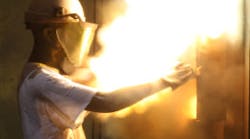Personal protective equipment (PPE) in the electric arc has been evolving since the early 1990s. With the introduction of OSHA Safety and Health Standards in the United States and arc test methods in ASTM International, the growth of knowledge in PPE and the proliferation of PPE for electric arc have grown throughout the world. Although misunderstandings and errors in marketing still abound, knowledgeable users, manufacturers, and researchers have helped make materials more comfortable, protective, and available for many more work situations. OSHA 1910.269 in 1994, NFPA 70E in 2000, 2004, and 2009, and now CSA Z462 have codified clothing for electric arc. Arc ratings are critical to proper PPE selection; however, some flame-resistance standards (even international standards) are inadequate to protect workers in electric arc exposures.
Standards for arc-rated materials
Most of the arc flash PPE research is occurring in Canada and the United States, although countries all over the world are developing and testing products. Following are some highlights regarding specific pieces of PPE.
Clothing — Clothing materials must meet ASTM F1506, which assures basic flame resistance and assigns an arc rating to the fabric. Fabrics that claim to be flame-resistant but that do not meet F1506 are often treated melting fabrics and have no place in most flame situations. Many flame-resistant (FR)-treated acrylics claim to be flame-resistant and offer wording such as “will not sustain flames under high heat conditions.” These types of materials are dangerous in electric arcs, as they will melt in an electric arc or in a flash fire — and cannot point to a real standard.
Often, manufacturers cite ASTM D6413, which is only a test method with no pass/fail criteria, or they cite NFPA 701, which is a “curtain” standard, not a clothing standard. Other material manufacturers cite ASTM F1358, “Standard Test Method for Effects of Flame Impingement on Materials Used in Protective Clothing Not Designated Primarily for Flame Resistance.” As the title implies, this is not a flame-resistance standard for clothing you would wear in an arc or flash fire. It is really only useful on garments that could be exposed to a small flame, such as a surgical garment. Picking the proper standard for clothing specification is critical.
Rainwear — The F1891 standard is the only international standard specifying which flame-resistant rainwear is useful for electric arc protection. NFPA 2112 for flash fire also cites rainwear, but the most commonly cited standard is ASTM F1891, which basically includes the same arc requirements as F1506 but with a requirement to test for Energy Breakopen Threshold (EBT) on all rainwear fabrics. This is expressed as an Energy Breakopen Threshold Above Stoll (EBTAS) rating.
This basically forces the tester to take the rainwear fabric to the point at which it breaks open the fabric (EBT), even if this is above the second-degree burn point (stoll). This test exposes melting FR rainwear materials that pass only small-scale tests, such as vertical flammability (2 sec after flame and 4 in. to 6 in. char length), thermal stability test (fabric must not melt, drip, separate, or ignite after 5 min. in a 500°F oven), or thermal shrinkage test (less than 10% after 5 min. in a 500°F oven) to a full-scale test like the ASTM F1959 arc rating testing. Every credible fire test, except for some strong specifications, such as NFPA 1971 or NFPA 1975 for firefighters, use full-scale testing in the specification.
Fall protection harnesses — ASTM F887 addresses fall protection arc ratings for harnesses, requires testing of the harness at 40 cal/cm2, and doesn't allow melting and dripping of components under those conditions. Additionally, the standard requires the exposed harnesses to pass an ANSI-approved drop test after the arc exposure. The standard only applies to new harnesses; however, we have seen harnesses over the past few years fail after a year's use when retested. Only heavy nylon and para-aramid harnesses have been observed to pass this test. None of these harnesses has been involved in injuries to our knowledge to date. Using the para-aramid harnesses would eliminate the concern about ignition, since these materials are non-melting, unlike nylon.
High-visibility clothing — The issue for arc-rated clothing has been that the materials that met the EN 471 standard were not arc rated. Some claim flame resistance, but most are melting flame-resistant materials, which will increase burn in arc or flash fire conditions. CSA Z96 even allowed arc-rated and flash fire-rated clothing to meet a lesser standard for visibility, due to the nature of most arc-rated and flash fire-rated materials that precludes them from dyeing with fluorescent dyes. This put the arc and flame resistance on the top of concerns and allowed “bright clothing” for worker visibility, even if it didn't meet the more stringent requirements of the ANSI 107 or higher level CSA standard. Today, this is less necessary, because there are several materials on the market that meet both F1506 and ANSI 107/EN471/CSAZ96. Modacrylic materials (not to be confused with dangerous FR-treated melting acrylics) and blends of modacrylics and other materials can hold fluorescent dyes and maintain inherent flame resistance.
Gloves — Two types of gloves are now commonly available for arc flash protection.
-
Voltage-rated gloves (70E calls these “rubber insulating gloves”).
-
Arc flash gloves with no shock protection value.
Voltage-rated gloves can be arc tested to determine the incident energy ignition probability and the arc rating by a standard now in a final proposed version before ASTM. This standard will afford for improvements in flame resistance of gloves. Though Class 2 gloves (17kV maximum use voltage rated) have been used for years with very few incidents of ignition (and no known incidents of burns), the room for improved lighter weight and more flexible gloves is still a concern.
The ASTM standard for gloves D120 has a minimum thickness requirement on gloves that was initially determined to afford better life and durability, but the IEC standard for voltage-rated gloves allows for thinner gloves if they pass the voltage test. The ASTM specification for leather protectors worn over voltage rated gloves by OSHA law does not allow anything other than leather. A case for collaboration would be to open this standard to improvements in technology to make a leap from two pairs of gloves for electrical work. This could enhance worker acceptance of hand protection for shock and arc.
The arc-rated gloves without shock protection take many forms — from the carbon/aramid blended cut-resistant gloves to leather to rubber gloves. Rubber gloves made today can ignite at some level of arc exposure, but because of their use for shock protection, they are still the most commonly used for arc protection. Arc-rated gloves that do not provide shock protection can only be worn when the task calls for arc protection and does not have an associated shock hazard.
Underwear — The new 2009 NFPA 70E has a substantial change that will eliminate some hazards. The previous versions of the standard (2000 and 2004) required natural fiber underwear. This requirement resulted in a few fatalities (the two known instances occurred when workers were exposed to energies beyond the table's footnotes that would have required a flash study, and in one the worker did not wear additional protective gear required by the work situation). The new standard allows natural fiber underwear but does not allow it to count as part of the protective system. This moves workers to more flame-resistant underwear.
Winterwear — Some still fallaciously believe that wearing heavy cotton winterwear over a flame-resistant shirt will provide some protection. This is false. Many companies are now issuing flame-resistant winterwear that will act as a flash suit when worn with a hood to take advantage of the protection afforded by arc-rated winterwear. Some companies even allow winterwear or arc-rated rainwear to serve as flash suits year-round, eliminating the purchase of arc flash suits. Hoods are still needed, and the winterwear or rainwear system must meet the requirements of a flash suit in testing.
Faceshields — Faceshields are now required down to HRC 1. New faceshields are on the market with full spectrum color recognition. If faceshields haven't been replaced in the previous year or two, they might not be the most visible on the market. More companies are wearing balaclavas (newly defined in the 2009 standard as meeting HRC 2). Balaclavas or flash suit hoods meet the new standard.
Shoes - A few issues exist here.
-
Shock protection. Two standards exist for shoes and shock. One is called an Electrical Hazard (EH) rating [ATSM F2413 or CAN/CSA Z 195]. However, these ratings are only for the soles of the shoes. OSHA recognizes these but gives no guidelines on when they must be worn. The NFPA 70E standard doesn't directly mention these standards. ASTM F1117 standard is for dielectric shoes and is the only shoe standard recognized by the 70E standard. Normal shoes mentioned in several places are not assumed to have shock protection, but we recommend having all electricians' shoes meet the EH standards and provide dielectric overshoes for the specific hazards mentioned in NFPA 70E. Even dielectric shoes are for “secondary” shock protection and should not be used as primary protection from known step potential. The strength of the ASTM F117 standard is that each shoe is tested by the manufacturer, and the whole boot is tested within an inch from the top.
-
Arc flash protection — The standard recognizes that leather work shoes typically provide excellent arc flash protection and requires them for exposures greater than HRC 2. The standard assumes equal arc flash protection from dielectric shoes.
-
Other hazards — This is not directly addressed in the standard, but the new exception allows non-arc rated PPE when the AHJ deems the PPE necessary because of a greater hazard. The 130.7(C)(15) Exception No. 2: Non-FR protective equipment required for unusual hazards may be permitted by the AHJ. Many companies have arc tested shoes/rubber boots to assure they will not ignite in 40 cal/cm2 arcs to protect from other hazards such as chemicals.
Disposable arc-rated materials — Only one material exists that meets ASTM F1506, which is a non-woven aramid. Others work well in arc but don't meet the tear strength requirements. These non-safety-related requirements are slated to be removed from the F1506 standard, which will allow non-wovens to be chosen by the AHJ and still meet the NFPA 70E standard.
Hearing protection — Although there is no arc rating for hearing protection, arc tested hearing protection is commonly available in the form of ear canal inserts. Three types have been tested for ignition probability using the ASTM F1959 test setup and a modified panel. Two companies are planning to develop an arc-tested ear muff.
Choosing a PPE system
There are many factors besides arc rating to look for in arc-rated clothing, including moisture regain, feel, initial cost, and long-term cost of ownership, treatment and reliability of treatment, color fastness and other safety aspects, such as visibility. Although these aspects of clothing must be considered, they are beyond the scope of this article. Therefore, we will focus on the aspects that relate more to safety. Primary aspects of clothing systems to consider in specification include:
-
Does it meet the specific arc rating and flame resistance standard for this material (ASTM F1506, F1891, F887, F2178, etc.)?
-
Does the clothing system have the level of arc rating to meet your arc flash hazard assessment levels? This often requires an arc flash calculation study. The new 2009 NFPA 70E makes it more difficult not to have an arc flash study.
-
Does it meet other safety criteria for other hazards such as ANSI 107/EN 471/CSA Z96 High Visibility Clothing standards or chemical resistance or molten metal splash resistance, such as ASTM F955?
-
Is the material permanent in its flame resistance? Fabrics, such as aramids, modacrylics, FR rayon fibers, and carbonized fibers are inherently flame-resistant. Many treated cottons are rendered permanently flame-resistant by the nature of the chemical and treatment process. There are three primary chemical treatments for cotton, and the one used in the United States has a better durability record than the other two. Only one is commonly available in the U.S. market. However, even this chemical is not always durable. The manufacturer should have demonstrated competence in treatment and a documented testing process for assuring durability of the flame-resistant materials.
-
Choose the right manufacturers and service providers. There are more than five in the world that use a durable FR treatment process that is time tested. This is critical if not choosing an inherently flame-resistant arc-rated material. Investing in an arc-rated clothing system is a value proposition, and having serviceable garments is critical. Using an interesting fabric from a smaller player who doesn't have stock is not a good idea. Safety garments need to be readily available in a range of sizes with a reasonable delivery time. Not having stock should be a negative consideration.
-
Comfort is an important factor, because workers who wear the clothing all the time are more likely to be protected.
-
If used, is the hood system visible and wearable?
-
Consider fans or breathing apparatuses (depending on other factors), but breathing inside hoods is critical. If hoods are worn more than a few minutes at a time, they should be equipped with fans or a blower of some sort. A replaceable or repairable fan unit will save money in the long run, and the noise level, battery life, and effectiveness of the fan on fogging and breathing should be considered.
-
Is the face piece of the hood too close to the face? Some hood manufacturers cut corners in the test method by backing the face piece very close to the face. This makes the arc rating higher but makes non-fogging almost impossible even with an anti-fog treatment.
-
Will a respirator have to be worn at times in the hood? If so, then the face piece location is even more critical.
-
Are shock hazards near the head in the work process? If this is the case, consider a hood that goes under the hard hat, such as the newer goggle/balaclava systems.
-
Does the hood system allow replacement of facepieces? Irreplaceable face pieces will mean greater cost in the long run or even poorer worker sight as time passes. Proper care can extend face piece life, but replaceable face pieces are much more cost effective.
-
What is the peripheral vision allowable in the hood? Again, some designs allow much more visibility than others.
-
-
Other PPE requirements.
-
Have melting components of the PPE been considered?
-
What about disposable garments worn over or under arc-rated clothing for other hazards/reasons. Arc-rated garments, such as disposables made of a wood pulp flame-resistant treated fabric, are commonly available to replace polyester melting fabrics typically used for arc clothing.
-
Hoagland is a member of the IEEE and owner of e-Hazard.com, Louisville, Ky. He can be reached at [email protected].
Based on “PPE in the Electric Arc: A Case for Collaboration,” by Elihu “Hugh” Hoagland, IV. © 2009 IEEE.





